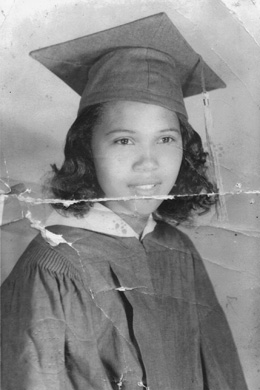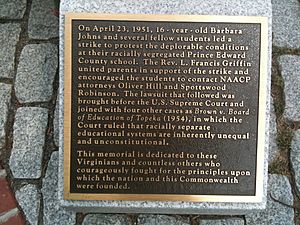Barbara Rose Johns facts for kids
Quick facts for kids
Barbara Rose Johns
|
|
|---|---|

Johns in a high school graduation photo (1952)
|
|
| Born | March 6, 1935 New York City, New York, U.S.
|
| Died | September 25, 1991 (aged 56) Philadelphia, Pennsylvania, U.S.
|
| Occupation | Civil rights activist, librarian |
| Known for | Davis v. County School Board of Prince Edward County R.R. Moton High School protest |
Barbara Rose Johns Powell (March 6, 1935 – September 25, 1991) was a brave leader in the American Civil Rights Movement. When she was just 16 years old, Barbara led a student strike. This happened on April 23, 1951, at R.R. Moton High School in Farmville, Virginia.
The students wanted equal education for everyone. Their actions led to a lawsuit called Davis v. Prince Edward County. This case became part of Brown v. Board of Education. That famous 1954 U.S. Supreme Court decision said that "separate but equal" public schools were against the law.
Contents
Early Life of Barbara Johns
Barbara Rose Johns Powell was born in New York City, New York, in 1935. Her family later moved back to Prince Edward County, Virginia. Barbara was the oldest of five children.
Her uncle, Vernon Johns, was a strong voice for civil rights. He often asked Barbara and her siblings about black history. This encouraged them to learn more. Barbara was greatly inspired by her uncle's outspoken nature.
Life at Moton High School
In Prince Edward County, schools were segregated. This meant black and white students went to separate schools. In 1951, Barbara was a junior at the all-black Moton High School. Another school in town was only for white students.
The resources at these schools were very unequal. Moton High School was built for about 200 students. But by 1951, it had twice that many! The school board put up temporary tar paper shacks to hold the extra students. Barbara was upset by these unfair conditions. She decided it was time to act.
Organizing the Student Strike
Barbara Johns met with her classmates. Together, they planned a student strike. On April 23, 1951, their plan began. They tricked the principal into leaving the school. Then, student leaders went to see the School Superintendent. He told them they were out of line.
Barbara had hoped county officials would understand. She wanted them to build a new school. Instead, they didn't seem to care. For the rest of the day, students protested inside and outside the school. They held signs that said, "We want a new school or none at all." Other signs read, "Down with tar-paper shacks."
NAACP Steps In
On April 25, 1951, lawyers from the NAACP arrived. They came to help the Moton High School students. The NAACP agreed to help, but with one condition. The lawsuit had to be for an integrated school system. It couldn't just be for better facilities.
A month later, the NAACP filed Davis v. County School Board of Prince Edward County. A federal court first supported segregation in Prince Edward County. But the NAACP appealed to the U.S. Supreme Court. Davis v. Prince Edward County joined four other cases. Together, they became the famous Brown v. Board of Education case. Many see the Moton student protest as the start of the wider Civil Rights Movement.
Barbara's Life After the Strike
Because of her role in the integration movement, Barbara faced threats. The Ku Klux Klan even burned a cross in her yard. Fearing for her safety, Barbara's parents sent her away. She went to Montgomery, Alabama, to live with her uncle.
After the strike, Barbara Johns lived a quieter life. She earned a degree in library science from Drexel University. She married William Powell and had five children. She worked as a librarian for the Philadelphia school system. Barbara continued this work until she passed away in 1991.
Barbara Johns' Legacy
Barbara Johns' important work for civil rights is sometimes overlooked. This is because she was just a teenager when she made such a big difference.
The Virginia Civil Rights Memorial opened in 2008. Barbara Johns and other students are shown on one side. A quote there says, "It seemed like reaching for the moon." The Library of Virginia also honored Barbara in 2005. They named her one of their Virginia Women in History.
Today, Barbara Johns is studied in Virginia's elementary school history classes. Students learn about her in the unit on Civil Rights.
In 2017, Governor Terry McAuliffe named the Office of the Attorney General after Powell. This honored her impact on the civil rights movement. In 2018, J.E.B. Stuart High School in Fairfax County, Virginia, was renamed Justice High School. This was done to honor Barbara Johns and others who worked for justice.
In 2019, Johns was featured in the New York Times series "Overlooked No More." This series adds obituaries for remarkable people who were not recognized at the time of their deaths. In 2020, Johns was inducted into the National Women's Hall of Fame.
On December 16, 2020, a commission in Virginia made a recommendation. They voted that a statue of Barbara Johns should represent Virginia in the National Statuary Hall. This statue would replace the current one of Robert E. Lee. The Lee statue was removed, and a statue of Johns is planned.


